In 2020 a month before the world went mad and into lockdown, I got my first fountain pen. It was a JinHao, the top didn’t fit properly, it was heavy and the nib was good but as hard as nails. I really wanted a fountain pen version of my Zebra G dip pen. What would be ideal would be a flex pen like I saw in all the videos but thought those were some distant fantasy. It seemed that the pens I wanted were either expensive – vintage collector’s items and not for sale, really niche high-end Japanese makes. All more than I could afford. It all seemed rather impossible….
Now two years later I can say – it’s not impossible, it’s not expensive, but you can save money and time by not doing what I did – hence this blog post for beginners looking to ‘flex’ their pens. be it a weird flex or normal flex 😉 The reason for writing this is I quite often get asked what is the best pen for a beginner on forums and FB groups, and I type out an essay and it makes sense to have it ready in one place 🙂
That said, I bet no-one ever asks again!
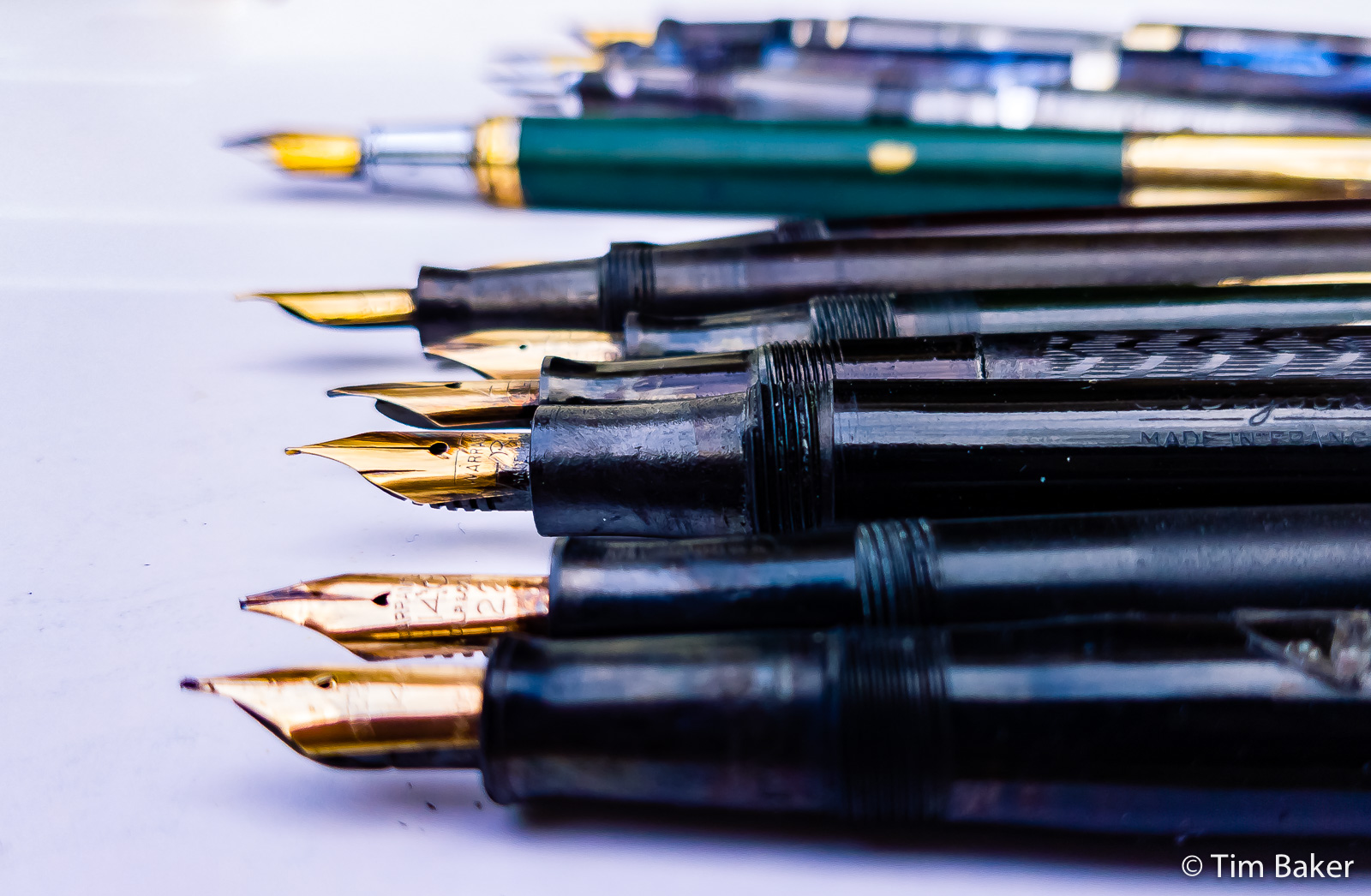
What are flex pens?
Flex pens are pens with nibs that give line variations, the aforementioned dip pen is a flex pen as used in the recent ink review you can see examples of flex in the different width line strokes. But it’s rather hard to use a dip pen with a pot of ink in the bus! Hence wanting to find the line variation of a dip pen with the form factor and convenience of a fountain pen I could carry in my pocket.
This might sound simple, but actually it took a LONG time to find pens like that…I made a lot of mistakes and had to kiss a lot of ‘frogs’ before I found pens I was happy with. There is a learning curve that seems massive to a beginner to Fountain Pen World but actually it’s less of a mountain and actually a small hill. I made a lot of bad choices, wasting time and money because I was scared of taking a few risks or learning some basic pen DIY or getting a few really cheap tools or even better improvising them! Dumb.
New (Weird) Flex – A Long Story of 3 Pens and the Cup of Shame
There are two options basically – new or vintage flex pens. It’s a long story, so TL:DR – jump to the hero of this story if you don’t want to read this. It might sound strangely negative to start with three pens to NOT buy, but I learned the hard way with my wallet, so consider this a warning.
Now at the start I was very much averse to vintage pens – I thought they might be unreliable, it would be hard to find the parts, a risky purchase.

So I spent a lot of time looking for and trying new flex pens – indeed one of the pens – the Fountain Pen Revolution (FPR) Himalaya V3 was locked down literally as it was coming from New York in early lockdown and it took 6 weeks as it was abandoned in the postal office in Brooklyn as COVID hit. Then I got hit with extra import duty as well…it wasn’t a good start.
I loved that pen, still love the nib – and it was a good start until some major issues hit, some almost immediately.
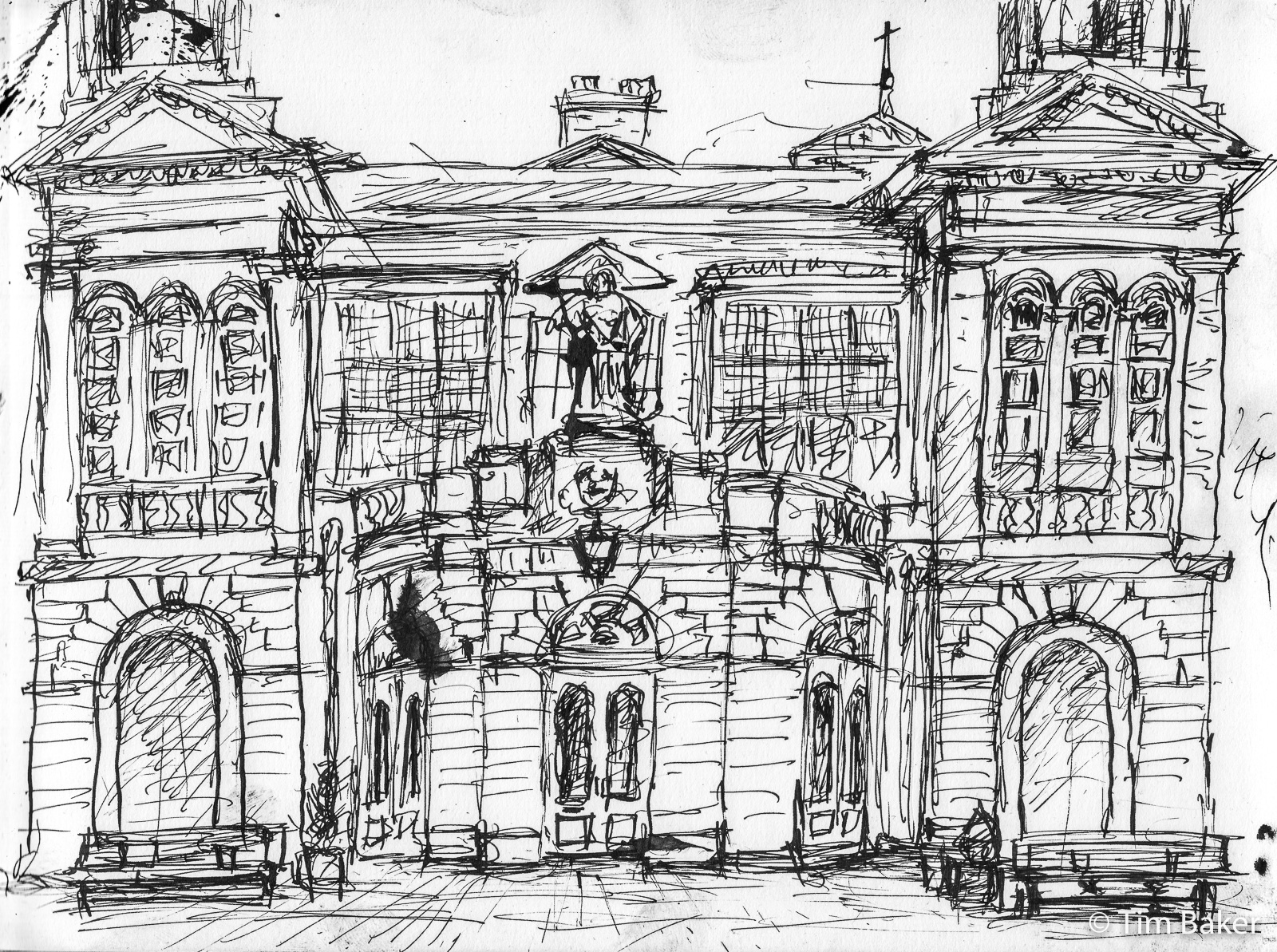
Kingston Market Hall, 5PM Challenge 77, FPR Himalaya V2 Ultraflex Pen and Lotte Sketchink, A4 pad.
Firstly it leaked. A lot. Into the cap, over my hands, over the page… it was a very ‘wet’ pen. The problem with that – along with getting ink on your drawings – is that ink would run out really fast. I’d have to fill the pen 2-3+ times for one A4 drawing. I know now that’s really bad, but at the time I accepted it as normal. Also the flex wasn’t actually a full flex – at this price point the FPR nib is probably the best you’ll get without spending hundreds on say a Pilot Namiki with a Pilot Falcon nib swapped in from Japan….but nothing like the real flex of a gold nib.
Thing is for some really dumb reason, the FPR uses a custom converter which you can’t get anywhere else, and it then mine blocked. I got another one for free from FPR (thanks!), but they couldn’t solve the leaking issue, even after heat setting the feed (putting the nib and feed in hot water) and trying silicon grease and even plumber’s tape around the feed to try and seat the nib better.
The issue of having to fill up on ink constantly was solved by eyedroppering the pen (putting ink into the body of the pen) but then the leaking got worse, and whereas before the pen would blurt too much ink on the page every odd line, now it would dump ink on the page every stroke.
It was a lemon of a pen, basically. Avoid. It now belongs in the Cup of Shame with my other failed/less loved pens.
So I did some research and found out about Kanwrite, an Indian company that people claimed is where FPR got their nibs from, and was similar so I hoped to have a FPR nib in a better pen. (This is complete bullshit, btw – look at the photo it’s rather obvious they aren’t the same nibs, and I’ve even swapped them and proved this, they don’t fit the same, and flex differently). Kanwrite is a bugger to buy from as they insist on using bank transfers and my bank wouldn’t transfer to them cos of fraud in the Kanpur area and not recognising their bank. After three tries and several strange intermediaries, I ordered the pen.
Again, took many weeks to arrive – the Heritage is a piston pen, and I got the demonstrator version. Thing is the Kanwrite has a firmer flex than FPR, has that weird smell which is the vegetal plastic, and had the opposite problem – it didnt supply enough ink to the nib! And then the piston semi-jammed and I couldn’t fill the ink fully….and Kanwrite just ghosted me when I asked for help. So Flex Pen of Shame #2 exit stage left into the Cup of Shame!
(Apparently they do gold nibs now? They might be better, but given as with FPR the shoddy nature of their pens, I am wary. I’d try it in a better pen. That said, feed and nib have to be aligned, it’s not as simple as putting a flex nib into any pen, the feed and pen have to be wet enough to drive the nib – usually you need to get both.)
I then heard about Noodler’s – the ink manufacturer making flex pens, and they weren’t as expensive as the Kanwrite or the FPR and were available in the UK without crazy bank transactions or import duty! Woo!
I got a Noodler’s Ahab, and loved it, it was rather fine, I’d say a semi-flex and firmer flex than I like – VERY firm flex, like a lot of steel nibs they can be too firm, and needed a lot of pressure. It had that same vegetal plastic smell, but a smaller pen….I went through the honeymoon period, but then stopped working for a bit, and it wasn’t used for two weeks.
When I came back to it – it had dried out completely. Yes two weeks is a little long to leave a pen, but it meant I could not trust the pen anymore and I like to rotate my pens…my other pens don’t dry out that quickly? Get in the Cup of Shame Bad Flex Pen #3!
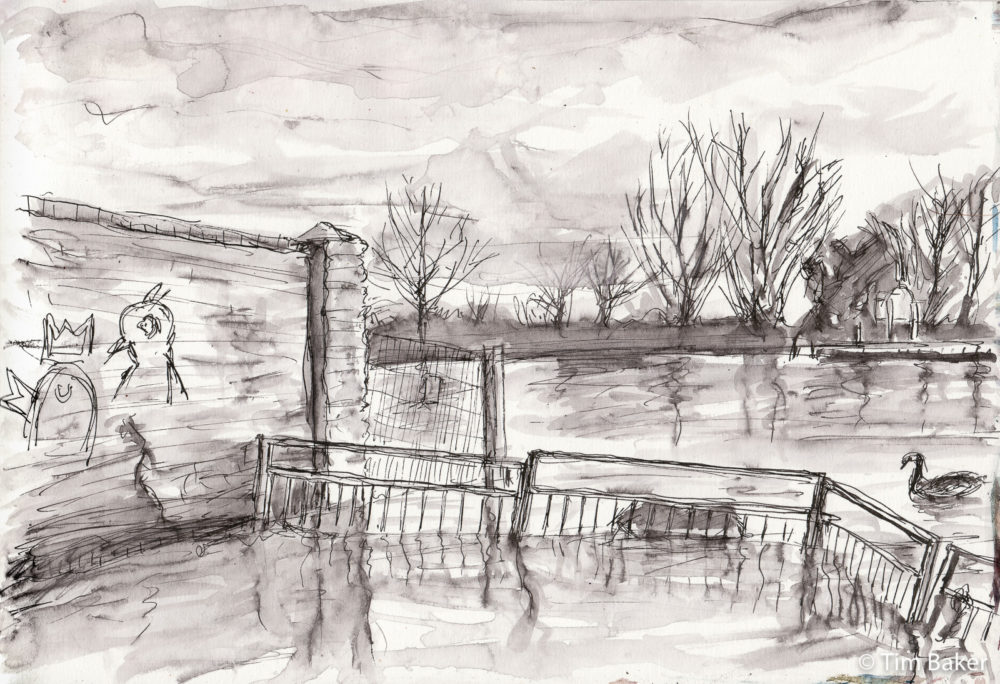
Canute, Fountain Pen and Wash, A4 sketchbook
A Surprise Hero of this Story!
So I by this point sort of gave up on flex pens until I randomly tried this pen. Chinese pens aren’t known for their flex – in fact the opposite, as that first JinHao showed or the Delike Alpha I have. Firm nibs, smooth, but no line variation at all…but that’s not completely the case.
Enter the Hero 395.
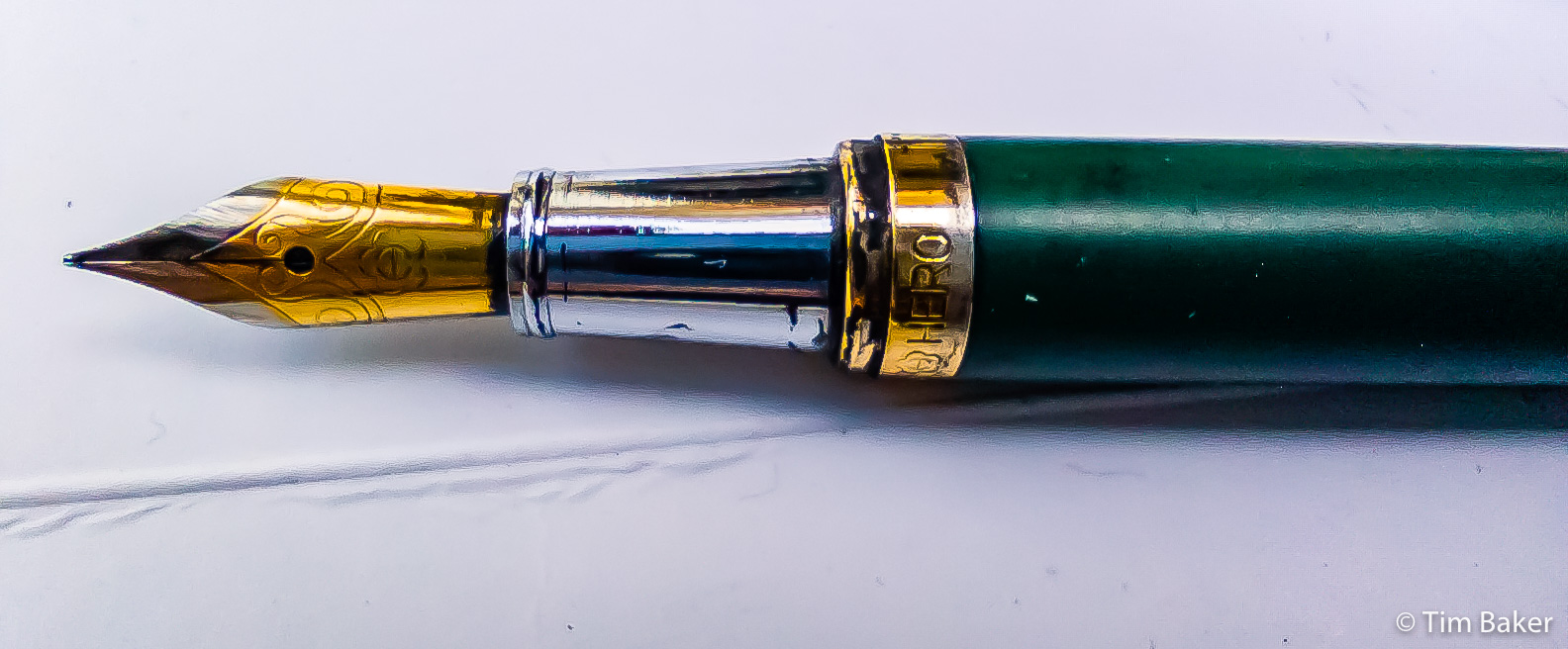
Marketed as a ‘vintage’ ‘new old stock’ pen (more of those two shortly) it’s actually a new pen. But it has semi-flex, not a big(ish) flex like FPR or vintage nibs and is available on Aliexpress in a variety of rather drab colours (dark green, dark blue, beigey grey…definitely going for that 1970’s waiting room aesthetic!). It’s a good combination with their ink and it comes with one of those retro Parker-style vacuum convertors, yet weirdly you can eyedropper it. Not sure what it’s made of, it feels like metal but unlike metal pens it doesn’t kvetch when you fill it with ink. (you should usually only ever use plastic pens to do that, officially).
But at a few quid – maybe a little more now VAT has to be paid (thanks Brexit!) and you can reduce that with Aliexpress coupons – but I have three of these and it’s an everyday carry pen. Unlike the vintage pens they are almost disposable, I’d not worry if I lost one – and I did once and then it turned up hence why I have three! A really good place to start.

Night Barge (second page), Hero 395 and wash, A4 sketchbook.
Vintage Flex Pens
So after all that faff, and having the Hero pens, I resigned myself to using that and not having the bigger flex of the FPR.
Until just over year ago I decided to try and risk a vintage pen and see if I could fix it as a side-line (that didn’t go well since I didn’t sell any of my pens yet!). That pen was Gerald – the Waterman unbranded 1940’s pen with wonderfully soft semi-flex which I still use today, and has gotten many siblings since…
The reason for the long warning about the three duff pens is that many beginners to fountain pens have said they don’t want to get a vintage pen because of cost, lack of knowledge, etc. I’m here to say: if you want true flex pen and don’t have many hundreds to spend on a new gold nib pen (and even then I am doubtful it will equal the nibmasters of old) – go vintage. Otherwise you are probably wasting your money.

Wahl Eversharp Symphony 707 (1950’s, NOS), The De La Rue Pen (30’s?, BHR), Evergood Pen – button filler (40’s/50’s?, NOS), Aikin Lambert Capitol Cabinet (30’s, BHR), Waterman unbranded Commando? Wxx? pen aka Gerald, (40’s), Mabie Todd Blackbird Thin (20’s, BHR), Mabie Todd Swan 3150 maroon
New for Old (NOS) and refurbished flex pens
Although many of the vintage pen manufacturers bit the dust when the Big Bad Biro entered the scene their stock sometimes lingers. This NOS – New Old Stock is a good way to enter the market, especially if it’s been checked or refurbished. You get a new vintage flex pen for cheap basically.
Now you won’t get a Waterman 52 new for anything other than silly money (and indeed even an old one…I’d avoid Waterman 52’s anyway there are better pens for cheaper even in that brand). But if you venture outside the better known brands, you will get a great flex pen for cheap or the price of a few parts. French made Evergood is one of these – someone has bought up old stock and selling them on eBay and elsewhere. These are great gold nibbed flex pens – button fillers as well, more convenient than a lever filler. More about that in the filling section. Check if they are refurbished though – some aren’t.
Another new/old flex pen that sometimes pops up are Wahl Eversharp pens. Peyton Pens used to have a stock of Symphony 707s, and I bought one – more of a 50’s style with a gold cap, and tbh unlike the Evergood, I don’t like the firm flex, I might sell it. This is the general trend with more modern vintage pens – around the 50’s the style tended more and more towards firm and hooded nibs, which doesn’t flex.
Remember not every vintage pen flexes.
If you are totally new to flex pens or FP’s generally – I do recommend buying a refurbished flex pen. Yes if you go to the big sites these are really expensive collector’s items, but check out eBay, you will find a bargain. Go for sellers with a track record and good feedback, that show their nibs proudly and even have writing examples and say the amount of flex. But as I said before google and research the pen, mistakes happen
(I bought the De La Rue flex pen recently and it was advertised as an Onoto. It isn’t an Onoto – bit naughty calling it that, even though DLR made Onoto pens, the De La Rue Pen is not the same thing).
Material Girl

Now we tend to take for granted that pens are usually plastic (acrylic) or metal. Not so back in the early days of the fountain pen, all sorts of materials were used before petroleum-based plastics. One of the early ones was ‘Hard Rubber’ aka Ebonite, usually abbreviated to BHR – black hard rubber or RHR – red hard rubber which tends to be rarer. This is rubber treated with sulphur to vulcanise it…it’s a great substance, rarer nowadays but still sometimes used in feeds.
It does fade when exposed to light to a brown colour, you will see that in pens (you can see that brown fading in my Blackbird Thin pen at the top of the photo above), and in severe cases of UV or water exposure the material cracks. So if you can get a black one, or one that isn’t so faded it’s yellowish brown or green, do so (warning: people do dye or ‘re-oxidise’ them and I have no idea how that affects the longevity of the pen).
You can quite often tell BHR by feel or look – the chasing patterns that is popular which you can see in the image above (third from the top, Aikin Lambert) or it has more of a matte feel. It also feels different to plastic, but polished BHR can feel deceptively similar. In that case the only way to tell is to repeatedly rub the pen to warm it up and sniff it. Yes it’s silly, but BHR/RHR gives off the smell of burnt tires when you do that.
Another substance was celluloid – yes like the film. And like the films of old, rather flammable so don’t put those pens near flames. If it’s 20’s-30s era pen and it’s translucent, striped or brightly coloured, it’s most likely celluloid. The pens look amazing, but again like Gremlins – keep away from water, heat and light.
Acrylic plastic as we know it really didn’t appear til the late 30’s or 40’s…those early pens can be less stable, avoid anything that’s discoloured or transparent. It will be fragile (google the make of pen to see what it should look like, and research your intended purchase…always).
Filling Up
As I mentioned there are many different filling methods – the oldest being the eyedropper (needing a pipette to fill it), which if you find in say a Mabie Todd Swan for a cheap price, snap it up! Check the nib is OK but otherwise those pens have very little to go wrong, apart from maybe needing to be cleaned or flushed….remember to avoid getting hard rubber wet though, don’t soak those parts in water.
Later on we have the lever filler which I have a lot of those pens. A much more convenient way to fill a pen, it’s a lever that presses on a bar which squeezes a rubber sac pushing the air – or ink out – and then you flick it up to fill the pen and it sucks up the ink. It’s very neat – it does mean you have to carry ink bottles or small sample vials though, but seriously if you want to use flex pens, you will have to anyway. They use too much ink, you’d be swapping cartridges all the time!


Other variants include twist fillers or plungers like the Onoto pens – a brand like the Waterman 52 you’ll need deep pockets for. Fixing those is a little more involved with special tools.
Depending on where you buy your flex pen, you might need to change the ink sac – for a button filler that can be a bit tricky (the tip with the Evergoods is remove the nib unit and attach the ink sac, not the button part unless you have to) so I recommend you buy one that’s been refurbished.
But it’s not impossible – I researched it for my Evergood to find it had already had been replaced!
How to replace an ink sac is beyond this guide, but it’s not as scary as you might think. If you’ve glued anything at all, you’ll be fine with it – it’s actually easier than even that guide suggests – VERY easy for the simplest of vintage filling methods – the lever filler. The only exception to this are the later 50’s and 60’s pens with ‘vacuumatic’ filling, usually Parker pens. Avoid those unless you get them professionally fixed.
Oh and if a guide tells you to glue the nib section back in – ignore that. You don’t have to, unless it’s loose, and friction fit means they usually don’t move around. Why make it harder for yourself in future?
I will say this – nib section removal pliers are actually ‘spark plug boot pliers’ – get them cheap at an online tool place, not a pen store. You can actually remove a section with a piece of rubber hose and a normal pair of pliers, using the rubber as a grip/cushion. If it’s glued you can heat it using a hand-drier (!) or gently with a hair drier held quite far away.
But in practice I’ve bought many vintage pens needing a new sac and only one needed any of that. 99.9% of the time, the nib section just pulls off. Also much talk of ‘knock out blocks’ and you can improvise using a metal imperial drill gauge, drill bits or flat ended screwdriver bits and some books to do that rather than a special expensive chunk of metal from a bijou pen store.
Again, usually you never need to remove a nib from the feed. Ever. It’s actually a wise thing not to, unless there is a good reason – try flushing and soaking first before any of that – it is usually just dried ink stopping it coming out. Brute force is usually not needed!
The Nib Detectives

A lot of buying a vintage flex pen is nib detective work – researching the nib, looking at the supplied photos closely, looking at other pens with the same nib and seeing if they flex. The general rule is if the shoulders of the nib – the bits at the side are swept back into more of a V-shape, it’s a flexy nib.
That doesn’t always run true though, but it’s a good indicator. Look at the photos for any cracks or missing tines (the bits of the nib either side of the slit) or uneven or missing tipping at the end of the nib. If someone doesn’t provide photos of the nib, or they are blurry – avoid unless you want to take a risk.
Yes I have bought a cracked nib and didn’t see the photos and the seller didn’t bring it to attention – I did get my money back but it was a teachable moment. And yes one of my first vintage purchases was a Summit pen – I collect British pen makes if I can – with a swept-back nib that’s hard as nails. Zero flex. It was only a tenner and I’ll sell it on someday but still…there is a risk and you will need to try a few flex pens before finding the perfect one.
That said, the reason Waterman pens are much recommended is that most of them, especially the Ideal nibs are semi-flex or better as standard – that’s why the unbranded 1940’s flex pens are one of my recommendations as they go cheaply on eBay, collectors don’t want them, but like my pen ‘Gerald’ they have lovely soft flex nibs. Not full flex, but better flex than most modern flex pens. I have a Canadian Waterman, also undervalued and good, a Waterman 32 which I suspect is as good as a 52, with an Ideal nib.
Other makes I recommend are Mabie Todd – the Swan and Blackbird range upto the 40’s/50’s has good gold flexible nibs usually. Never bought a Jackdaw, the cheapest range, as they were pens for school kids and I think they are actually quite rare as most were trashed.
Swan is top of the range, lovely pens. Blackbirds are good – I have a BHR Blackbird Thin from the 1920’s. Unlike the other flex pens I’ve mentioned they can have a cachet re: pricing though, with Mabie Todd pens it’s best to keep trying. I use an eBay snipe site with intentionally low bids and many pens…eventually you get a hit 🙂
Other makes that seem to go under the overpriced radar like Evergood – Aikin Lambert – I have a Capitol Cabinet, like the Evergood and the Swans it’s one of the most flexy pens I own.
Oh and always go for gold – 14k gold nibs. Those flex the best, don’t be fobbed off with plated or steel nibs, they won’t flex the same. Once you try a good gold flex nib you will see why the FPR et al aren’t actually the best. Not even close.
Flex pens with character
The only downside to buying vintage flex pens on the cheap and DIY fixing them is they can be rather temperamental unlike modern pens….quirky. This is usually down to the nib, so unless you can adjust it yourself (gentle bending goes a long way, but be careful) it’s best to stick to a professionally refurbished pens.
But remember these are items that are upto a hundred or more years old…they won’t work the same as a Preppy, nor should they be, even the refurbished models. I own both refurbished pens and ones I’ve fixed myself, and yes, they can all throw a rare wobbly.
Sometimes my flex pens are all angsty and not behaving on a certain paper – flushing and cleaning helps in those cases – and another day they are fine. It’s random, and like a racehorse you have to put up with some diva attitude cos when the pen is flying…it’s like none other. That’s why I carry modern and vintage pens, for the occasions when the vintage pens refuse to come out to play. It’s rare though.



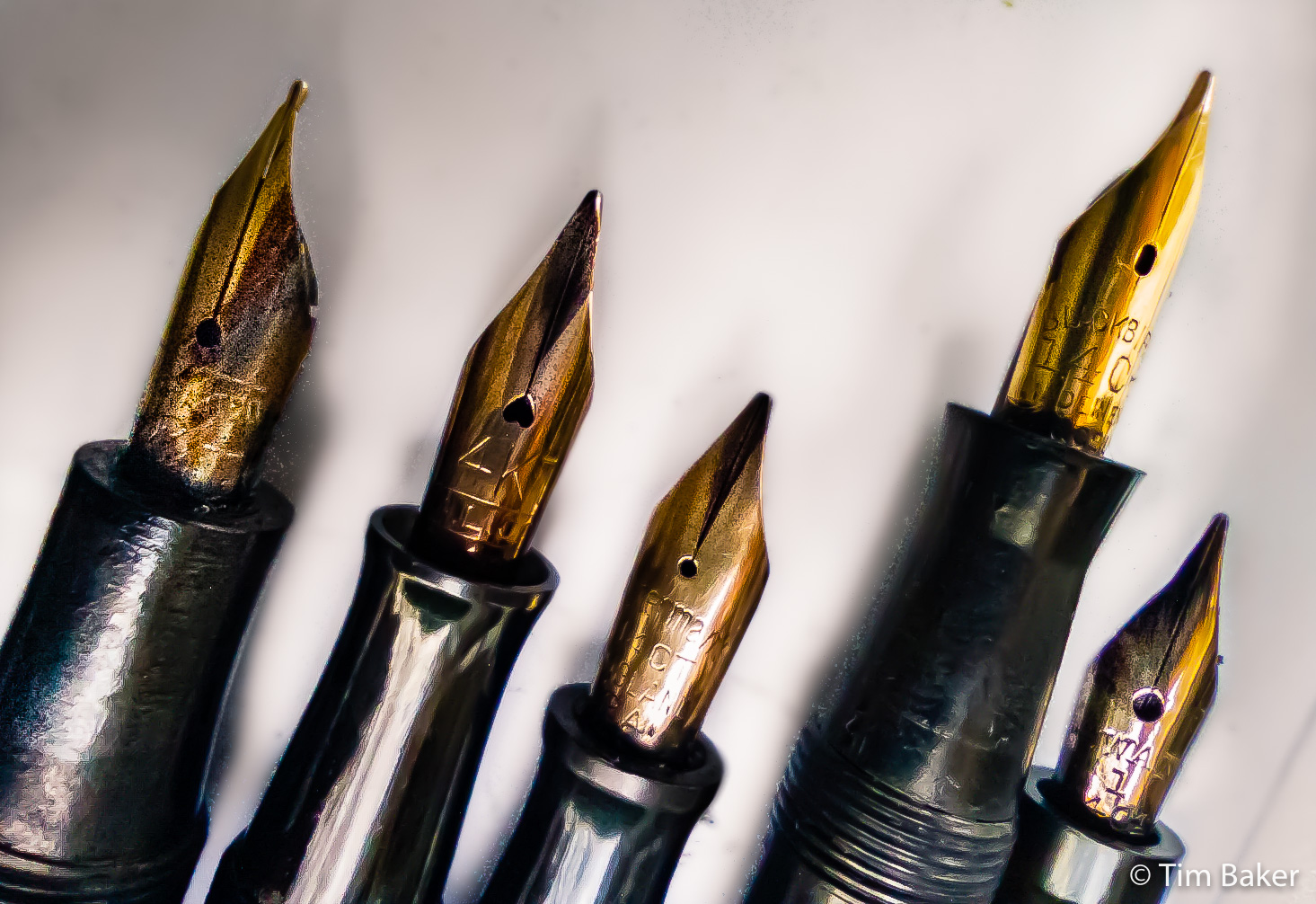

Leave a Comment! Be nice….